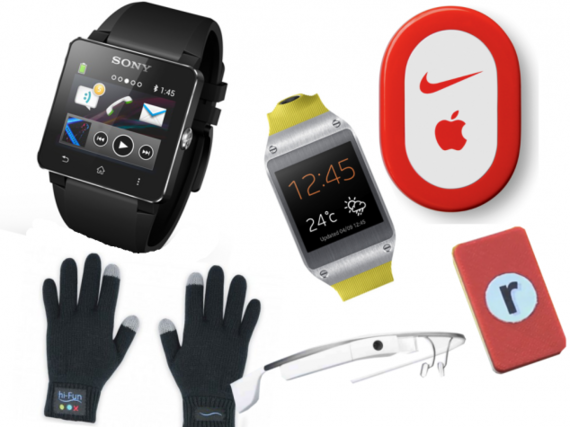Wearables have been spilling into the mainstream consciousness, and are now -- some say -- geared to take the market by storm. Whether it's wrist bands such as Jawbone's UP, Nike+ Fuelband and Fitbit's Flex, or Google testing and developing smart contact lenses that integrate with mobile devices to measure glucose levels for diabetics, wearable integration is surging.
Additionally, Apple rumors about the health-oriented iOS8, or companies like HealthWatch, that are developing clothing lined with electrode technology to monitor heart rate, the capacity for tech implementation into everyday wearable items is limitless, and the potential benefits are inspiring. While Siri, Cortana, and Google Now highlight the potential of voice technology within the market, smartphone devices have their boundaries, and while voice integration has evolved over the past decade, it has yet to strike a chord with the general public that makes the masses demand it.
Looking at the current wearable landscape, it's evident that fitness bands, glasses, watches and even sweaters are creating the opportunity to combine digital aspects with physical presence. Companies are demonstrating how new technologies cannot only improve the simplicity of our daily lives, but more importantly, our wellness. The applications are endless. They will encourage wearers to be more engaged in their fitness, help modify behavior, help coach their owners into better connecting with their own selves, and provide a platform for patients and physicians to share data. Most importantly, they will educate and empower users to take control of their wellbeing, help physicians and patients monitor medical issues, and ultimately, make better life choices.
Speak Up to Be Truly Heard
These days, everybody's talking about sensors. From, pulse-meters, to spectrographic cameras, a key component to the wearable market, as seen with products like Samsung's Galaxy Gear, and the upcoming Motorola Moto 360, has been the push to leverage voice recognition technology to harmonize with existing technologies.
We believe the role of voice could be greatly extended still. As a matter of fact, it's not at all farfetched to believe that the key sensor for gauging wellness has always been there -- the microphone. Every mobile device (current and emerging) that we own has the ability to pick up on our speech, and with it something immeasurably crucial to our wellbeing -- our emotions. For our voice carries not only our consciously careful choice of words, it also carries our vocally transmitted emotional constructs -- a fact known to anyone who has ever heard the following simple three words -- "Have a nice day." Studies in neuropsychology in the last 50 years have demonstrated that vocal intonation has a bigger impact in communication than your actual choice of words. When this potential is reached on wearables, it will open the technological floodgates to data that until now remained unseen.
Clearly, voice matters. Voices carry not only our words, but also our feelings, our moods, and indications of our general emotional status. With the growing proliferation of wearable devices, their "always-on" characteristics, and their integration with voice-enabled mobile devices, collecting and analyzing vocally transmitted emotions and tracking our emotional wellbeing over time, is now finally a viable possibility.
While initial inception of speech technology limited your smartphone to know when you wanted to call someone, that same device can now understand your emotional side. In the hands of professionals, this innovation will allow users to track their states of emotional wellness over a long period of time, and allow professional caregivers and doctors a more transparent glimpse into the evolution of a patient's wellbeing - adding another layer of information to other sources of data that physicians already use when tracking more physical parameters, such as caloric intake, BMI, blood pressure, etc.
A recent study by IDC, reveals that in the year 2018, the wearable technology market will see about 111.9 million wearables being used around the globe. The integration of voice will enable the ability to monitor emotional wellbeing over time, especially in correlation to the onset of different activities or events. The resulting analytic data can be assessed in relation to happiness, depression, and overall daily mindsets on various types of application in conjunction to other information reported by the user or collected by personal devices.
What to Listen For?
Now that Google Glass is available to the average consumer, and Nike FuelBands (as well as their constituents) are flooding the market, it's time for wellness applications to emerge. Nike, Apple, Sony and Samsung have positioned themselves as front runners in the space; we're seeing a lot of the components essential for wellness coming together, especially within the coming months of 2014 and the years beyond.
From wearable devices to operating systems (i.e. the latest iOS8 health tracking rumors), the ability to use, activate, and monitor these always-on devices is the "perfect storm" for vocally extracted wellness data. Look for wellness apps to pair emotion with additional health data, providing a unique look into the deep inner workings of our bodies and minds. Over the past few decades there have been a large amount of breakthroughs in the market. Now, new platforms need to bring everything together in one centralized space via wearables. With new apps providing large scale data, this type of wellness tracking will also result in medical knowledge being able to advance at breakneck speeds.
Look for voice to have an integral part within the expansion of health and wellness in the next 12 months.
